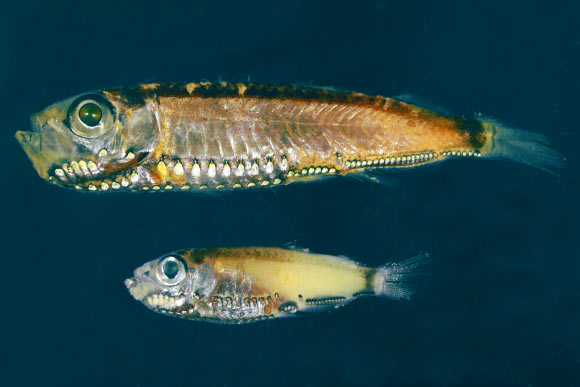An international team of researchers has found a new photoreceptor type in the eyes of deep-sea pearlsides, which have an unusual visual system adapted for twilight conditions. The research appears in the journal Science Advances.

Maurolicus muelleri (top) and Maurolicus mucronatus (bottom). Image credit: Fanny de Busserolles, University of Queensland.
Most vertebrate animals — including humans — have a duplex retina comprising two photoreceptor types: rods for dim-light vision and cones for bright-light and color vision.
However, deep-sea fishes are only active in dim-light conditions. Hence, most species have lost their cones in favor of a simplex retina composed exclusively of rods.
Although pearlsides (genus Maurolicus) have such a pure rod retina, their behavior is at odds with this simplex visual system.
Contrary to other deep-sea fishes, pearlsides are mostly active during dusk and dawn close to the surface, where light levels are intermediate and require the use of both rod and cone photoreceptors.
“Deep-sea fish, which live at ocean depths below 650 feet (200 m), are generally only active in the dark, so most species have lost all their cones in favor of light-sensitive rods,” said lead author Dr. Fanny de Busserolles, from the Queensland Brain Institute at the University of Queensland in Brisbane, Australia, and the Red Sea Research Center at the King Abdullah University of Science and Technology, Saudi Arabia.
“Pearlsides differ in that they are mostly active at dusk and dawn, close to the water’s surface where light levels are intermediate.”
To explore this paradox, Dr. de Busserolles and co-authors studied the visual system of two species of pearlsides, Maurolicus muelleri from the Norwegian fjords and Maurolicus mucronatus from the Red Sea.
“Humans use their cones during the day and rods at night, but during twilight, although not ideal, we use a combination of both,” Dr. de Busserolles said.
“Pearlsides, being active mainly during twilight, have developed a completely different solution. Instead of using a combination of rods and cones, they combine aspects of both cells into a single and more efficient photoreceptor type.”
The team found that the cells — dubbed ‘rod-like cones’ — were tuned perfectly to the pearlsides’ specific light conditions.
“Our study improves understanding of how different animals see the world and how vision might have helped them to conquer even the most extreme environments, including the deep sea,” said senior author Professor Justin Marshall, also from the Queensland Brain Institute at the University of Queensland.
“Humans love to classify everything into being either black or white. However our study shows the truth might be very different from previous theories.”
“More comprehensive studies, and caution, are needed when categorizing photoreceptor cells into cones and rods.”
_____
Fanny de Busserolles et al. 2017. Pushing the limits of photoreception in twilight conditions: The rod-like cone retina of the deep-sea pearlsides. Science Advances 3 (11): eaao4709; doi: 10.1126/sciadv.aao4709







